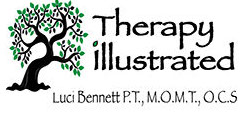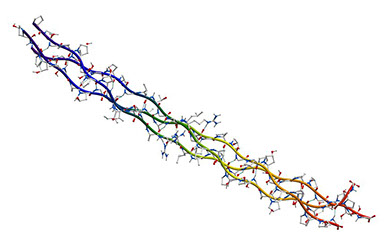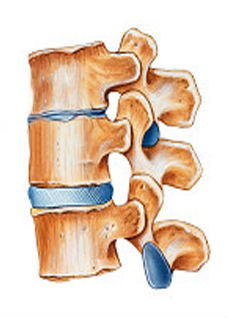


Arthritis
There are several types of arthritis that can affect the spine: rheumatoid arthritis, osteoarthritis, psoratic arthritis, gout, lupus, and septic arthritis. Osteoarthritis is related to changes that occur in our bodies with aging. All of the other types of arthritis are either a disease process or an autoimmune issue, and each type is medically managed differently.
The most common type is known as osteoarthritis. As we get older, there are a multitude of changes that occur in all the joints and tissues of our body. These changes are driven at a cellular and biochemical level, specifically the collagen cell.
 When you look at a piece of collagen under the microscope, it looks like threads. These threads are woven with other collagen threads using crosslinks to form a matrix of tissue that looks like fabric. This fabric is embedded with other cells called proteoglycans that attract a certain amount of water to be held in that fabric. There are a variety of other cells and materials that combine with collagen/proteoglycans to make up all the tissues of the musculoskeletal system. This includes bone, disc, cartilage, connective tissue, fascia, ligaments, and tendons.
When you look at a piece of collagen under the microscope, it looks like threads. These threads are woven with other collagen threads using crosslinks to form a matrix of tissue that looks like fabric. This fabric is embedded with other cells called proteoglycans that attract a certain amount of water to be held in that fabric. There are a variety of other cells and materials that combine with collagen/proteoglycans to make up all the tissues of the musculoskeletal system. This includes bone, disc, cartilage, connective tissue, fascia, ligaments, and tendons.
There are two major changes that occur at a cellular level as our body ages. These changes involve the size and amount of both collagen fibers and proteoglycan cells present in the tissue. These proteoglycans maintain a certain level of hydration within the collagen matrix. The amount of water present contributes to the health and the resiliency of the tissue. The rate of development for these cells slows so there are fewer cells available in the tissue, which results in a loss of hydration. The collagen fiber tends to become more dense and brittle with higher numbers of cross links which increases the overall stiffness of the tissue.
These and other cellular changes are reflected in the appearance and the function of the different tissues. The water content of the disc diminishes and the discs become drier with less elasticity. Cartilage lining of the facet joints will change especially with excessive stress by developing signs of mild inflammation that evolves into an erosion which thins the lining. Ligaments will thicken and stiffen. Extra stress on the bone results in the development of bone spurs along the edges of the body where the discs attach or along the joints.

These changes are the collective characteristics of osteoarthritis. They can be intensified with certain systemic diseases or with injuries or overuse or even being too sedentary. The loss of collagen elasticity and dehydration of our tissue sets our bodies up for being more vulnerable to overuse tissue breakdown as well as making it harder and taking longer to recover from injuries.
Everyone's body develops arthritis. It is a part of aging. General symptoms of arthritis are stiffness in the morning. Some people have inflammation in their arthritic joints which causes pain, but not all arthritic joints are inflammed.
Does everybody with arthritis have pain?
The contents of BackPainExplained web site including the text, graphics, images, and other material are for informational purposes only. The content of this web site is not intended to be a substitute for professional medical advice, diagnosis, or treatment. Always seek advice of your physician or other qualified health professional with questions you may have regarding a medical condition. Do not delay seeking medical advice or disregard professional treatment advice because of something that you have read on BackPainExplained.
Call your physician or 911 if you think that you have a medical emergency. Reliance on any information within BackPainExplained web site is solely at your own risk.